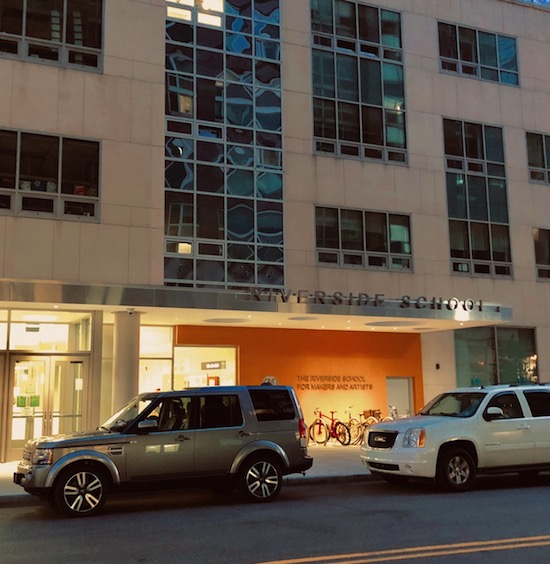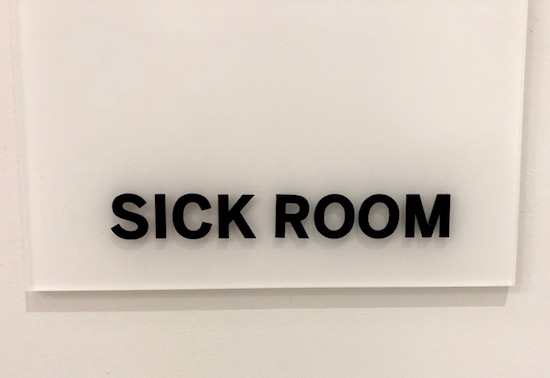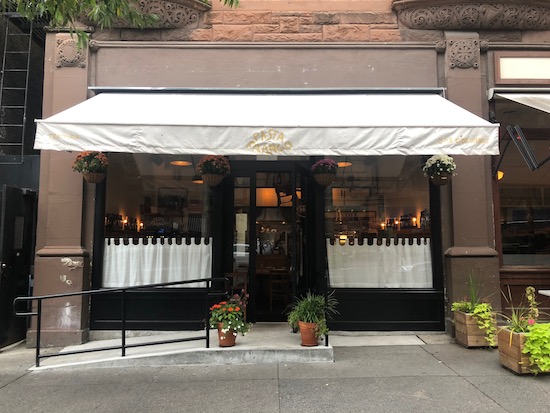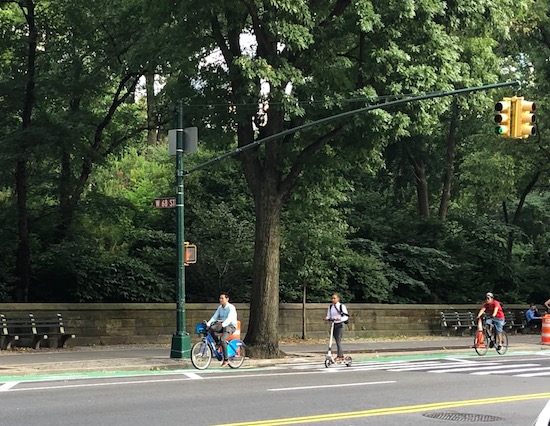By Jackie Delamatre
On a recent Monday morning, PS 191’s assistant principal stood in front of the gleaming new school building on 61st Street and West End Avenue greeting families by name despite her back-to-school cold. Of the parents streaming in to drop off their children, most were not aware that the school they prized for its warmth and community had been suffering from a nursing shortage that has plagued schools across the city.
One parent, Lindsay Milgram, said it was news to her. “Every school should have a nurse,” she said. “That’s fundamental for safety.” Another mom, Kelly Jay, who recently received a hardship transfer to move her kids to the school from the Bronx, said the news was “scary.”
“A nurse is necessary,” she said, asking who would take temperatures and determine if children need emergency care.

PS 191, The Riverside School for Makers and Artists.
Queen Verden, wearing an orange, red, and yellow camouflage print jumpsuit and sunglasses, said she knew all about the nursing shortage. Her son has severe allergies and passes out from heat. Her family transferred to PS 191 this year. On the first two days of school, she tried to see the nurse to share information about her son’s medical issues but soon discovered there was no nurse in the building. Worried about him, she eventually put his inhaler in his backpack and told him to self-administer. She also asked his twin to keep an eye on him because he knew his brother well enough to know if “something was going wrong.” When the school finally got a nurse, Verden encountered a different contract nurse each day and was frustrated by the need to explain her son’s situation again and again. She now hopes she can rely on those nurses to enter her son’s record into the system for future contract nurses.
According to Kim Watkins, President of the Community Education Council for District 3: “The need for nurses is increasing and the shortage is increasing and we’re on a pathway to a dangerous situation. It’s a really big deal.”
Watkins says there are three different staffing structures for nurses in city schools. Department of Education nurses get paid the most and receive the best benefits and UFT representation. But some schools get nurses that work for the Department of Health with less pay and fewer benefits and are represented by DC37. It is harder to find nurses to fill the latter positions, but there aren’t enough DOE nurse positions to staff every school. The third type of nurse is the contract nurse who provides care on a temporary basis. This type is cheaper for the government because it does not pay benefits. Watkins says this type of nurse often calls in sick and unlike a consistent staff nurse, doesn’t know the kids and their medical needs.
“It’s just a nightmare,” says Watkins about the shortage.
A well-informed source who was willing to speak on background told the West Side Rag that turnover for non-DOE nurses is very high. The few the city manages to recruit leave for higher paying jobs in hospitals or closer to their homes outside of Manhattan (where their salary can pay the bills). As a result of the shortage, parents are forced to leave work to deal with their child’s medical needs, especially when that child has a chronic condition such as asthma, diabetes, or allergies – or the need for catheterization or tube feeding. Every day nursing supervisors have to make decisions about which schools get a nurse and which don’t based on clinical needs. The Department of Education did not respond to requests for comment about the shortage.
Yelena Ferrer is one parent who had enough of the shortage. Last year, her family spent four months running back and forth to her son’s school to give him insulin when the school’s regular nurse was on maternity leave and the contract nurses weren’t trained in diabetes care.
“Eventually we realized that was wrong,” she said. They contacted the American Diabetes Association who said it was a problem across New York City schools and encouraged them to join a class action lawsuit with other families facing similar difficulties.
In response to the lawsuit, Ferrer said the city has amped up their diabetes care in schools but other conditions are not necessarily being addressed fully. “Unfortunately,” Ferrer said, “just because they responded to me doesn’t mean they’re going to make a change for” kids with other conditions like asthma. “I think there has to be a revolt from those parents saying I’m not going to put up with that.”
According to the West Side Rag’s anonymous source, on one recent day there were 23 schools uncovered by nurses in Manhattan alone. In general, this shortage affects poor black and Hispanic students the most. Meanwhile, the problem is getting worse as new school sites and new programs like Universal PreK and 3-K (pre-school for 3-year-olds) open across the city. Until salaries and benefits are raised, she said, it will only get worse.
Sara Lind, an Upper West Side parent and candidate for City Council, says her own son has a severe nut allergy and her daughter has a seizure disorder and that she is nervous about sending them to school because of this shortage. “If there is no nurse there and something happens, I don’t know what would happen.”
“These people are important,” Lind said about school nurses. “We need to pay them commensurate with the value they bring and keeping our children alive is obviously very valuable. It’s not a great reflection on our society that we’re not paying them enough.”










Why not use EMTs. They are cheaper and trained to handle both minor issues and manage emergency first aid and hand off to higher level care.
Not allowed, by NYS law “school nurses” must be professional registered nurses (RNs). Even Licensed Practical Nurses (LPNs) aren’t allowed except in unique or special circumstances.
A licensed professional nurse can work independently of direct physician supervision. Practical nurses OTOH must always work under the license/supervision of either a RN or doctor.
If a school as a licensed doctor or RN on staff, then yes a LPN can be employed, if not, then no.
EMTs are not even in this picture as they aren’t nurses of any sort.
https://www.schoolhealthny.com/site/default.aspx?PageType=3&ViewID=7b97f7ed-8e5e-4120-848f-a8b4987d588f&RenderLoc=0&FlexDataID=489&PageID=143
https://www.p12.nysed.gov/sss/schoolhealth/schoolhealthservices/schoolnursememo.html
As with many other NYC civil servant positions that of Department of Education/school nurses is well below current private market compensation.
NYC DOE pays only between $60k to about $66k for school RNs. Meanwhile a newly licensed RN can get $73k to over $90k at nearly all private NYC hospitals/healthcare systems. Experienced RNs depending upon specialty can earn high $90k to six figures in private sector.
This review pretty much sums things up:
https://www.glassdoor.com/Reviews/Employee-Review-New-York-City-Department-of-Education-RVW7663889.htm
As for the revolving door; that is pretty common in nursing, especially with new graduates/licensed RNs.
Everyone wants to work in a hospital, but those places are hard to get into these days. So many nurses will take whatever job they can get (especially if they are newly licensed without experience), and bide their time. After one or two years, and or soon as a hospital offers them job, they quit school, nursing home, rehab, home care, etc…
Salaries r not comparable to hospitals.